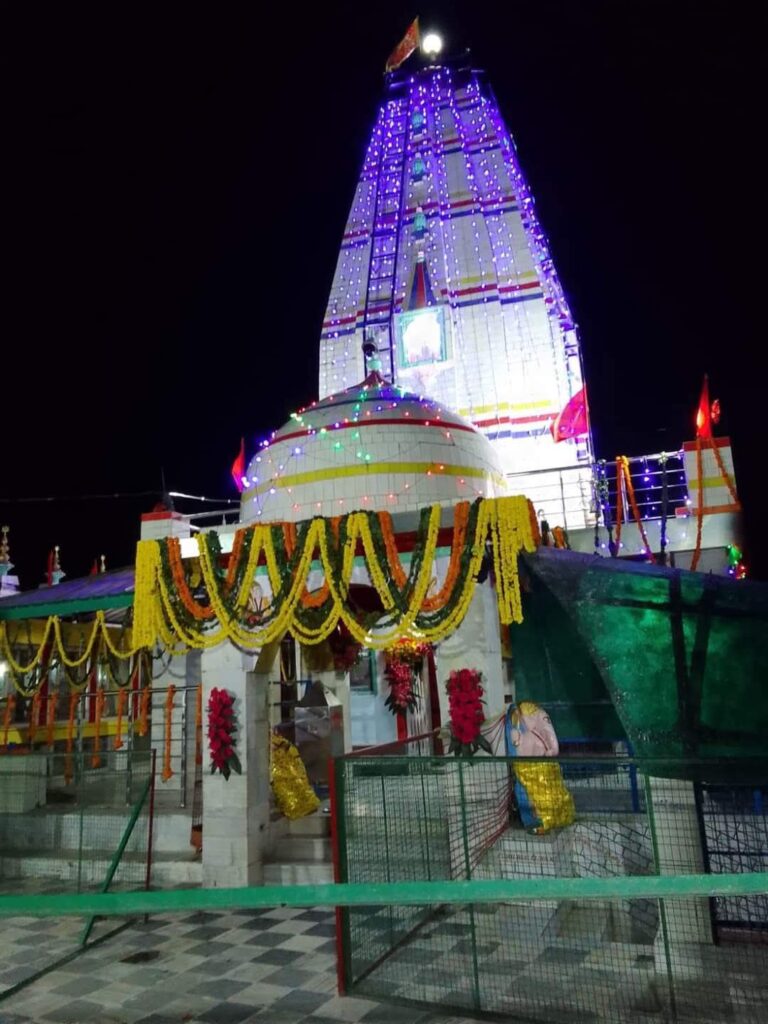Perched at an altitude of 1,500 meters (4,921 feet) on Basahi Dhar in the Jogindernagar Valley of Himachal Pradesh, Chaturbhuja Temple is a revered Hindu shrine dedicated to Goddess Chaturbhuja, a four-armed form of Goddess Durga. Located 24 kilometers from Jogindernagar and 50 kilometers from Mandi, this ancient temple blends spiritual significance with the rugged beauty of the Mandi district’s hills. Known for its vibrant Navratri celebrations and deep-rooted local beliefs, it draws devotees seeking blessings amidst a serene Himalayan backdrop. In this comprehensive guide, we’ll explore its history, significance, travel details, and why it’s a must-visit in 2025.

Chaturbhuja Temple: A Legacy of Devotion and Myth
The Chaturbhuja Temple’s origins are steeped in folklore, with some locals attributing its construction to the Pandavas from the Mahabharata, though no historical records confirm this. Situated on the Jogindernagar-Sarkaghat road, the temple’s name, “Chaturbhuja” (meaning “four-armed”), reflects the goddess’s divine form, symbolizing strength and protection. A striking belief tied to the temple claims that on the night of Daiyan Amavasya (a dark moon night associated with demons), a mythical battle unfolds near Parashar Lake between gods and rakshasas. If the gods lose, a sacrificial animal—or even a human—is chosen, revealed to the temple’s priest (goor) through a hallucinatory ritual called khel on the next full moon. This lore, while debated, underscores the temple’s mystical aura, making it a focal point of faith in the region.
Why Visit Chaturbhuja Temple?
Spiritual Vibrance
The temple is a hub of devotion during Navratri, when pilgrims from across Himachal Pradesh and beyond flock here for blessings. Night vigils (jagran) and communal feasts (bhandaras) fill the air with spiritual energy, offering a profound experience.
Himalayan Serenity
Set on Basahi Dhar, the temple overlooks the Jogindernagar Valley, with sweeping views of pine forests, distant peaks, and the Beas River’s settlements. Its tranquil perch makes it a peaceful retreat for meditation and reflection.
Cultural Insight
The temple’s rituals and festivals, like the khel tradition, provide a window into Himachali culture, blending ancient beliefs with vibrant community celebrations, especially during Navratri.

Best Time to Visit Chaturbhuja Temple
- Navratri (March-April and September-October): Peak season, with crowded festivities and a lively atmosphere.
- April to June: Pleasant weather (15°C to 25°C) and clear views, ideal for a calm visit.
- October to November: Post-monsoon freshness enhances the valley’s beauty.
Winters (December-February) bring cold (0°C to 10°C), while monsoons (July-August) make the hilly roads challenging but reveal lush greenery.
How to Reach Chaturbhuja Temple
By Air
Kangra Airport (Gaggal), 65 kilometers away, is the nearest airport. Taxis from Kangra to Jogindernagar take 2-3 hours, followed by a 24-km drive to the temple.
By Train
Jogindernagar Railway Station, 24 kilometers away, is the closest narrow-gauge terminus from Pathankot (143 km). From the station, hire a taxi or take a local bus.
By Road
The temple is 24 kilometers from Jogindernagar and 50 kilometers from Mandi via the Jogindernagar-Sarkaghat road. From Jogindernagar, taxis or buses take 45 minutes to 1 hour, winding through hilly terrain.
Attractions at Chaturbhuja Temple
- Temple Sanctum: The modest stone-and-wood structure houses the four-armed Goddess Chaturbhuja, adorned during festivals.
- Basahi Dhar Views: Panoramic vistas of the valley and Beas River settlements offer a scenic reward.
- Navratri Festivities: Nightly prayers, jagran, and bhandaras create a vibrant spiritual experience.
Nearby Destinations
Jogindernagar
24 kilometers away, known for its hydel power heritage, narrow-gauge railway, and adventure spots like paragliding at Billing.
Baijnath Temple
45 kilometers from Jogindernagar, a 9th-century Shiva temple with intricate architecture.
Barot Valley
35 kilometers away, a picturesque spot with a trout fishery and trekking trails.
Accommodation and Food
Jogindernagar offers guesthouses and hotels (₹1,000-₹2,500/night), like Hotel Uhl or HPTDC’s The Uhl. Near the temple, basic homestays or camping may be available. Food includes Himachali staples—dal, rice, roti, and siddu—at local dhabas or temple bhandaras during festivals.
Travel Tips for Chaturbhuja Temple
- Timing: Open daily, with peak activity during Navratri; plan for early mornings or evenings.
- Gear: Warm layers (winter), sturdy shoes for the climb, and rain gear (monsoon).
- Respect: Dress modestly and follow temple customs, especially during rituals.
- Connectivity: Mobile signals are patchy; carry cash as ATMs are in Jogindernagar.
Why Chaturbhuja Temple Stands Out
Chaturbhuja Temple blends spiritual mystique with Himalayan charm. Its unique rituals, like the khel tradition, and its peaceful hilltop setting distinguish it from urban shrines, offering a blend of faith, culture, and nature that resonates deeply.
Chaturbhuja Temple in Jogindernagar, Himachal Pradesh, is a sacred gem where ancient beliefs meet breathtaking vistas. Whether you’re drawn by its miracle lore or the tranquility of Basahi Dhar, it promises a soulful journey. Plan your visit, embrace its traditions, and let this Himalayan shrine captivate you.


